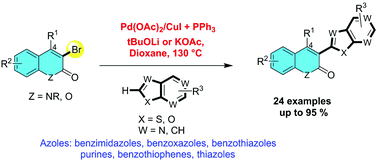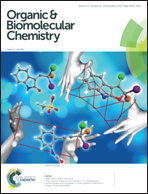A general Pd/Cu-catalyzed C–H heteroarylation of 3-bromoquinolin-2(1H)-ones†
Abstract
3-(Heteroaryl)quinolin-2(1H)-ones were synthesized in good to excellent yields using a bimetallic catalytic system through the C–H heteroarylation strategy. Starting from 3-bromoquinolin-2(1H)-ones, various azoles have been successfully used. In all cases, the reactions take place rapidly in dioxane and efficiently proceed in the presence of a bimetallic Pd(OAc)2/CuI as the catalyst, PPh3 as the ligand and LiOtBu or KOAc as the base.


 Please wait while we load your content...
Please wait while we load your content...